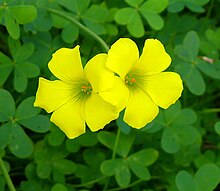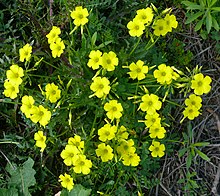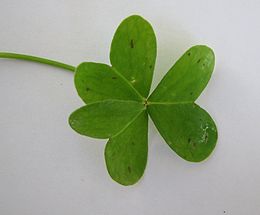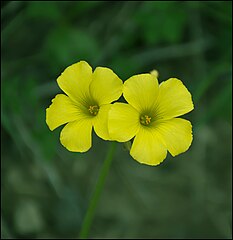Oxalis pes-caprae
| Oxalis pes-caprae | |
|---|---|

| |
| Sourgrass | |
| Scientific classification | |
| Kingdom: | Plantae |
| Clade: | Tracheophytes |
| Clade: | Angiosperms |
| Clade: | Eudicots |
| Clade: | Rosids |
| Order: | Oxalidales |
| Family: | Oxalidaceae |
| Genus: | Oxalis |
| Species: | O. pes-caprae
|
| Binomial name | |
| Oxalis pes-caprae | |
| Synonyms[1] | |
|
List
| |
Oxalis pes-caprae (African wood-sorrel, Bermuda buttercup, Bermuda sorrel, buttercup oxalis, Cape sorrel, English weed, goat's-foot, sourgrass, soursob or soursop; Afrikaans: suring; Arabic: hommayda (حميضة)[2]) is a species of tristylous yellow-flowering plant in the wood sorrel family Oxalidaceae. Oxalis cernua is a less common synonym for this species. Some of the most common names for the plant reference its sour taste owing to oxalic acid present in its tissues. Indigenous to South Africa, the plant has become a pest plant in different parts of the world that is difficult to eradicate because of how it propagates through underground bulbs.
Name
[edit]Oxalis pes-caprae is often called by the common name sourgrass due to its moderately sour flavor. This sourness is caused by an exceptionally high content of oxalic acid.
The specific epithet pes-caprae means 'goat's-foot', possibly in reference to the shape of the leaf.
Description
[edit]
The Oxalis pes-caprae flower is actinomorphic, with a calyx composed of five free or slightly fused sepals, a sympetalous corolla composed of five fused petals, an androecium composed of ten free stamens in two ranks, and a compound pistil. Native populations in South Africa are heterostylous, flowers of long-styled plants have a stigma held above the two ranks of stamens, mid-styled plants have the stigma in between the two ranks of stamens and short-styled plants have a stigma below both ranks of stamen. In the non-native range the plants largely reproduce vegetatively and many populations have only one style length and the plants never produce seed.[3][4] Like most African Oxalis species, it produces adventitious subterranean propagules. These take the form of true bulbs in botanical terms, which is unusual among dicotyledons. In fact, Oxalis pes-caprae produces small bulbs copiously, whereas most other African species produce fewer, larger bulbs.
Uses
[edit]The plant is palatable and in modest quantities is reasonably harmless to humans and livestock. In South Africa it is a traditional ingredient in dishes such as waterblommetjiebredie ('water flower stew').[5]
The plant has been used in various ways as a source of oxalic acid, as food, and in folk medicine. The raw bulbs have been used to deal with tapeworm and possibly other worms. The plant has been used as a diuretic, possibly hazardously, in the light of observations in the following section. The lateral underground runners, which tend to be fleshy, have been eaten raw or boiled and served with milk.[6] The golden petals can be used to produce a yellow dye.[7]
Invasive species
[edit]
Indigenous to South Africa, Oxalis pes-caprae is an invasive species and noxious weed in many other parts of the world, including the United States (particularly coastal California),[8] Europe,[9] The Middle East and Australia.[10]
Control
[edit]The plant has a reputation for being very difficult to eliminate by mechanical methods once it has spread over an area of land.[11] The weed propagates largely through its underground bulbs and this is one reason why it is so difficult to eradicate, as pulling up the plant, even with the roots, can leave some of the bulbs behind. Soil in which the plant has grown is generally contaminated with many small bulbs.
Kluge & Claassens (1990) reported a potential biocontrol agent using Klugeana philoxalis, a larval feeder on shoots of O. pes-caprae.[12][13]
O. pes-caprae is also a host to broomrape, though it is not clear that that is of significance as a control agent.[14]
Two studies have reported successful control using two different non-selective, consumer-grade herbicides. Imazapyr[15] applied in late March 2016 at low concentration appeared to completely prevent re-sprouting of O. pes-caprae bulbs in the San Francisco area.[16] He reports "The difficulty of control of Bermuda buttercup has led some to consider control impractical... The use of herbicides may also have high efficacy for habitat restoration of infested fields and woodlands." Glyphosate[17] was used successfully on a Mediterranean island.[18] They report, "The use of glyphosate was found to be the only efficient control method, leading to a significant decrease in O. pes-caprae cover as well as to a recovery in native species cover and richness. The effect of the other control methods was negligible."
Hazards
[edit]This section possibly contains original research. (November 2012) |
The leaves or roots of Oxalis pes-caprae are used in some parts of the world as a food,[19][20] although the high levels of calcium oxalate in the plant may bear some risks. Such risks can be reduced if the plant parts are boiled first.[21] Oxalic acid is toxic in large quantities, a concern in regions such as southern Australia where Oxalis pes-caprae grows invasively in enormous quantities and in high densities.[citation needed] Various sources suggest that oxalis ingestion causes calcium oxalate kidney stones, but clinical experience and physiological considerations make it unlikely that any realistic intake of Oxalis would affect human liability to kidney stones.[citation needed] Accordingly, some Australian references to the hazards of oxalis to livestock tend to be dismissive of this risk.[citation needed]
However, in spite of its comparatively benign nature, where it has become dominant in pastures, as sometimes happens outside South Africa, Oxalis pes-caprae certainly can cause dramatic stock losses. For example, when hungry stock, such as sheep released just after being shorn, are let out to graze in a lush growth of Oxalis pes-caprae, they may gorge on the plant, with fatal results, as has been found in South Australia at least.[22]
Such stock fatalities patently have little logical connection with the presence or absence of oxalate kidney stones. For one thing, the fatal effects on sheep are far too rapid to result from the growth of bulk kidney stones. The plant has been found to be nutritious, but too acidic to be good fodder, largely being left untouched by grazing stock. When stock do consume large quantities, the effects typically involve death in several weeks with symptoms suggesting chronic oxalate poisoning, including tetany, or sudden death with extensive renal damage.[6] Such damage suggests the twofold effect of calcium immobilisation (the tetany) and the formation of Calcium Oxalate Monohydrate raphides in the kidney tissue.[23] The histotoxic effects of the raphides in kidney have by now been investigated.[24]
Oxalis poisoning of stock is not a serious forage concern in South African pastures, unless exceptionally favoured by overgrazing.
Gallery
[edit]-
Flowers and leaves
-
Open flower and a bud
-
Flower detail
-
Bulbs and roots
-
Entire uprooted plant
-
Leaf detail
-
Lots of flowers
-
Two flowers
-
A field of yellow blooming Oxalis pes-caprae during a spring bloom in its indigenous habitat on the west coast of South Africa (West Coast National Park). Other native flowing species such as the white-coloured Dimorphotheca pluvialis and orange-coloured Arctotis hirsuta can be seen blooming alongside it.
-
A large field of yellow blooming Oxalis pes-caprae during a spring bloom in its indigenous habitat on the west coast of South Africa. Other native flowing species such as the white-coloured Dimorphotheca pluvialis and orange-coloured Arctotis hirsuta can be seen blooming alongside it. The photograph illustrates the large seasonal fields in which the plant has evolved to flower.
See also
[edit]References
[edit]- ^ "Oxalis pes-caprae L." Plants of the World Online. Board of Trustees of the Royal Botanic Gardens, Kew. 2017. Retrieved 16 November 2020.
- ^ Bosman, D. B.; Van der Merwe, I. W. & Hiemstra, L. W. (1984). Tweetalige Woordeboek Afrikaans-Engels. Tafelberg-uitgewers. ISBN 0-624-00533-X.
- ^ Rottenberg, Aaron; Parker, John S. (7 May 2004). "Asexual populations of the invasive weed are genetically variable". Proceedings of the Royal Society of London. Series B: Biological Sciences. 271 (suppl_4): S206-8. doi:10.1098/rsbl.2003.0135. PMC 1810042. PMID 15252985.
- ^ Castro, Sílvia; Ferrero, Victoria; Costa, Joana; Sousa, Ana João; Castro, Mariana; Navarro, Luis; Loureiro, João (2013-08-01). "Reproductive strategy of the invasive Oxalis pes-caprae: distribution patterns of floral morphs, ploidy levels and sexual reproduction". Biological Invasions. 15 (8): 1863–1875. doi:10.1007/s10530-013-0414-2. ISSN 1573-1464. S2CID 17974421.
- ^ S. J. A. de Villiers (2010). Cook and Enjoy. NB Publishers. ISBN 978-0-7981-4919-8.
- ^ a b Watt, John Mitchell; Breyer-Brandwijk, Maria Gerdina: The Medicinal and Poisonous Plants of Southern and Eastern Africa 2nd ed Pub. E & S Livingstone 1962
- ^ Michael Tortorello (April 5, 2012). "A New Generation Discovers Grow-It-Yourself Dyes". The New York Times.
- ^ Cal-IPC profile
- ^ Papini, A.; Signorini, M.A.; Foggi, B.; Della Giovampaola, E.; Ongaro, L.; Vivona, L.; Santosuosso, U.; Tani, C.; Bruschi, P. (2017-12-29). "History vs. legend: retracing invasion and spread of Oxalis pes-caprae L. in Europe and the Mediterranean area". PLOS ONE. 12 (12): e0190237. Bibcode:2017PLoSO..1290237P. doi:10.1371/journal.pone.0190237. PMC 5747460. PMID 29287103.
- ^ Department of Primary Industries, Victoria, Australia. "Soursob (Oxalis pes-caprae) (Nox)". Victorian Resources Online. Retrieved 8 June 2017.
{{cite web}}: CS1 maint: multiple names: authors list (link) - ^ Elmore, C. L. & Cudney, D. W. (January 2002). Ohlendorf, B. (ed.). "Creeping Woodsorrel and Bermuda Buttercup". Pest Notes. Publication 7444. Agricultural & Natural Resources, University of California: 2. Retrieved 25 June 2010.
- ^ Kluge, R. L.; Claassens, M.; "Klugeana philoxalis Geertsema (Noctuidae: Cuculliinae), the first potential biological control agent for the weed Oxalis pes-caprae L."; Journal of the Entomological Society of Southern Africa 1990 Vol. 53 No. 2 pp. 191–198
- ^ "Oxalis pes-caprae". Retrieved 2009-12-22.
- ^ "Oxalis pes-caprae L. (Oxalidaceae); Bermuda Buttercup". Retrieved 2009-12-22.
- ^ "Weed Control Methods Handbook: Tools and Techniques for Use in Natural Areas 7h.1, 2001". Retrieved 2022-04-01.
- ^ "Management of Bermuda Buttercup (Oxalis pes caprae ) in the Peninsula Watershed of the San Francisco Public Utilities Commission 2017" (PDF). Retrieved 2022-04-01.
- ^ "Weed Control Methods Handbook: Tools and Techniques for Use in Natural Areas 7e.1, 2001". Retrieved 2022-04-01.
- ^ Lazzaro, Lorenzo; Ferretti, Giulio; Bianchi, Elisabetta; Benesperi, Renato (3 September 2019). "Treatment by glyphosate-based herbicide allowed recovering native species after Oxalis pes-caprae L. invasion: indications from a Mediterranean island 2019". Plant Biosystems. 153 (5): 651–659. doi:10.1080/11263504.2018.1536083. S2CID 91677579. Retrieved 2022-04-01.
- ^ Bown, Deni (1995). Encyclopedia of herbs & their uses. Herb Society of America. Dorling Kindersley. ISBN 0-7894-0184-3. OCLC 32166152.
- ^ Sturtevant, E. Lewis (1972). Sturtevant's edible plants of the world. U. P. Hedrick. New York: Dover Publications. ISBN 0-486-20459-6. OCLC 718374.
- ^ Chai, Weiwen; Liebman, Michael (April 2005). "Effect of Different Cooking Methods on Vegetable Oxalate Content". Journal of Agricultural and Food Chemistry. 53 (8): 3027–3030. doi:10.1021/jf048128d. ISSN 0021-8561. PMID 15826055.
- ^ Bull, L.; Australian Veterinary Journal, 1929, Vol. 5 p. 60
- ^ McMartin K (November 2009). "Are calcium oxalate crystals involved in the mechanism of acute renal failure in ethylene glycol poisoning?". Clin Toxicol. 47 (9): 859–69. doi:10.3109/15563650903344793. PMID 19852621. S2CID 26702305.
- ^ Wiessner, John H.; Hasegawa, Andrew T.; Hung, Linda Y.; Mandel, Gretchen S.; Mandel, Neil S.; "-- Mechanisms of calcium oxalate crystal attachment to injured renal collecting duct cells"; Kidney International (2001) 59, 637–644; doi:10.1046/j.1523-1755.2001.059002637.x










